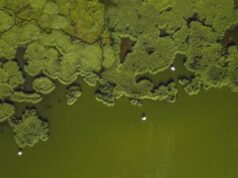Jasper Kirkby in front of the CLOUD prototype, with a sketch to illustrate the possible link between galactic cosmic rays and cloud formation.
Credit: Image courtesy of CERN
A novel experiment, known as CLOUD (Cosmics Leaving OUtdoor Droplets), begins taking its first data today with a prototype detector in a particle beam at CERN1, the world’s largest laboratory for particle physics. The goal of the experiment is to investigate the possible influence of galactic cosmic rays on Earth’s clouds and climate. This represents the first time a high energy physics accelerator has been used for atmospheric and climate science.
The CLOUD experiment is designed to explore the microphysical interactions between cosmic rays and clouds. Cosmic rays are charged particles that bombard the Earth’s atmosphere from outer space. Studies suggest that cosmic rays may influence the amount of cloud cover through the formation of new aerosols (tiny particles suspended in the air that seed cloud droplets). Clouds exert a strong influence on the Earth’s energy balance, and changes of only a few per cent have an important effect on the climate. The CLOUD prototype experiment aims to investigate the effect of cosmic rays on the formation of new aerosols.
Understanding the microphysics in controlled laboratory conditions is a key to unravelling the connection between cosmic rays and clouds. CLOUD will reproduce these interactions for the first time by sending a beam of particles – the “cosmic rays” – from CERN’s Proton Synchrotron into a reaction chamber. The effect of the beam on aerosol production will be recorded and analysed.
The collaboration comprises an interdisciplinary team from 18 institutes and 9 countries in Europe, the United States and Russia. It brings together atmospheric physicists, solar physicists, and cosmic ray and particle physicists to address a key question in the understanding of clouds and climate change. “The experiment has attracted the leading aerosol, cloud and solar-terrestrial physicists from Europe; Austria, Denmark, Finland, Germany, Switzerland and the United Kingdom are especially strong in this area” says the CLOUD spokesperson, Jasper Kirkby of CERN. “CERN is a unique environment for this experiment. As well as our accelerators, we bring the specialist technologies, experimental techniques and experience in the integration of large, complex detectors that are required for CLOUD.” An example in the present CLOUD prototype is the gas system, designed by CERN engineers, which produces ultra-pure air from the evaporation of liquid oxygen and liquid nitrogen. “It’s probably the cleanest air anywhere in the world”, says Kirkby.
Find your dream job in the space industry. Check our Space Job Board »
The first results from the CLOUD prototype are expected by the summer of 2007. The full CLOUD experiment includes an advanced cloud chamber and reactor chamber equipped with a wide range of external instrumentation to monitor and analyse their contents. The temperature and pressure conditions anywhere in the atmosphere can be re-created within the chambers, and all experimental conditions can be controlled and measured – including the “cosmic ray” intensity and the contents of the chambers. The first beam data with the full CLOUD experiment is expected in 2010.
Story Source: Materials provided by CERN. Note: Content may be edited for style and length.











